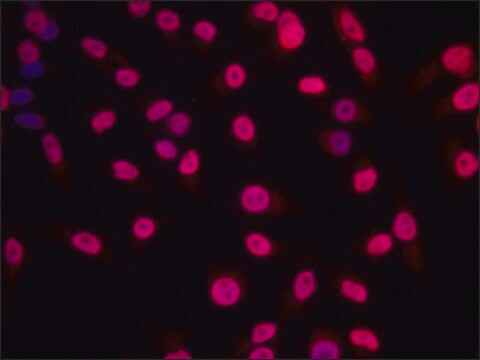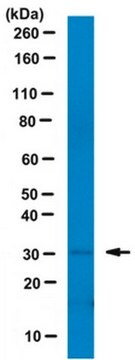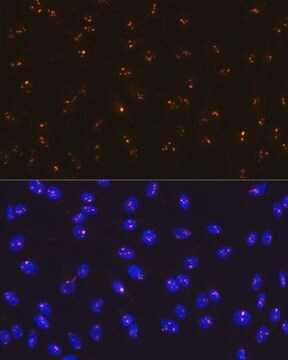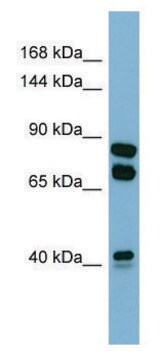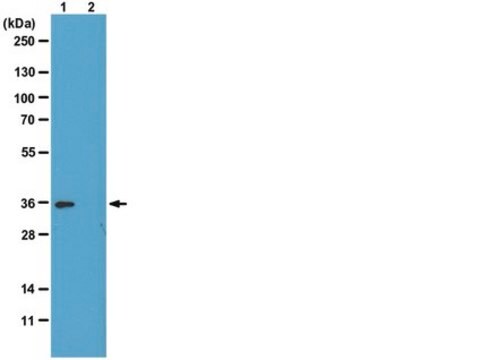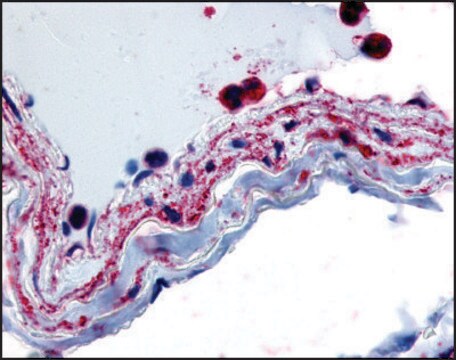推薦產品
生物源
mouse
抗體表格
purified immunoglobulin
抗體產品種類
primary antibodies
無性繁殖
1G6, monoclonal
物種活性
Drosophila
包裝
antibody small pack of 25 μg
技術
ChIP: suitable (ChIP-seq)
immunoprecipitation (IP): suitable
western blot: suitable
同型
IgG1κ
NCBI登錄號
UniProt登錄號
目標翻譯後修改
unmodified
一般說明
Histone H1 (UniProt: P02255; also known as H1) is encoded by the His 1 gene (Gene ID: 318854) in Drosophila species. Histone H1 is a linker histone that is involved in the organization and maintenance of chromatin higher order structure and plays an active role in the control of DNA replication and cell proliferation. The linker histone H1 family members are a key component of chromatin and bind to the nucleosomal core particle around the DNA entry and exit sites. Histone H1 is essential for the condensation of nucleosome chains into higher-order structures. In metazoans, H1 histones are smaller in size with about 200 amino acids. They have a short N-terminal tail, a central globular domain, and a long basic C-terminal tail. The central globular domain is shown to be highly conserved among all H1 subtypes. Manipulating levels of H1 histone can lead to both up- and down-regulation of specific genes. Depletion of H1 results in a massively altered chromosome structure with loss of chromosome banding. In Drosophila, a 20% reduction in H1 content leads to cessation of growth beyond the larval stage. Histone H1 undergoes phosphorylation mainly in the tail region, especially the C-terminal tail, where several {(S/T)-P-X-(K/R)} motifs are located that are recognized by cyclin-dependent kinases (CDKs). Phosphorylation levels are reported to be lowest during the G1 phase of the cell cycle and increase during S phase and reach maximum levels in mitosis. (Ref.: Hergeth, SP., and Schneider, R (2015). EMBO Rep. 16(11); 1439-1453).
特異性
Clone 1G6 is a mouse monoclonal antibody that detects Histone H1 in Drosophila species.
免疫原
GST-tagged recombinant fragment corresponding to 148 amino acids from the C-terminal half of Drosophila Histone H1.
應用
Anti-Histone H1, clone 1G6 Antibody, Cat. No. MABE1885, is a highly specific mouse monoclonal antibody that targets Drosophila Histone H1 and has been tested for use in Chromatin Immunoprecipitation (ChIP), ChIP-seq, Immunoprecipitation, and Western Blotting.
ChIP-seq Analysis: A representative lot detected Histone H1 in ChIP-seq applications (Iwasaki, Y.W., et. al. (2016). Mol Cell. 63(3):408-19).
Immunoprecipitation Analysis: A representative lot immunoprecipitated Histone H1 in Immunoprecipitation applications (Iwasaki, Y.W., et. al. (2016). Mol Cell. 63(3):408-19).
Chromatin Immunoprecipitation Analysis (ChIP): A representative lot immunoprecipitated Histone H1 in Chromatin Immunoprecipitation applications (Iwasaki, Y.W., et. al. (2016). Mol Cell. 63(3):408-19).
Immunoprecipitation Analysis: A representative lot immunoprecipitated Histone H1 in Immunoprecipitation applications (Iwasaki, Y.W., et. al. (2016). Mol Cell. 63(3):408-19).
Chromatin Immunoprecipitation Analysis (ChIP): A representative lot immunoprecipitated Histone H1 in Chromatin Immunoprecipitation applications (Iwasaki, Y.W., et. al. (2016). Mol Cell. 63(3):408-19).
品質
Evaluated by Western Blotting in Drosophila S2 cell lysate.
Western Blotting Analysis: A 1:500 dilution of this antibody detected Histone H1 in Drosophila S2 cell lysate.
Western Blotting Analysis: A 1:500 dilution of this antibody detected Histone H1 in Drosophila S2 cell lysate.
標靶描述
~35 kDa observed; 26.36 kDa calculated. Uncharacterized bands may be observed in some lysate(s).
外觀
Format: Purified
其他說明
Concentration: Please refer to lot specific datasheet.
未找到適合的產品?
試用我們的產品選擇工具.
分析證明 (COA)
輸入產品批次/批號來搜索 分析證明 (COA)。在產品’s標籤上找到批次和批號,寫有 ‘Lot’或‘Batch’.。
我們的科學家團隊在所有研究領域都有豐富的經驗,包括生命科學、材料科學、化學合成、色譜、分析等.
聯絡技術服務
